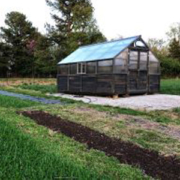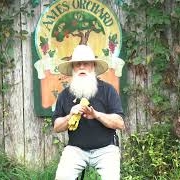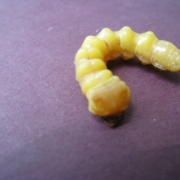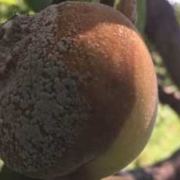Pear Trees Exemplify Resilience
 Print This Post
Print This Post
By Guy Ames, NCAT Horticulture Specialist
Resilience is the latest buzzword in the lexicon of sustainable agriculture…and for good reason. Resilience is the ability to recover or bounce back after a challenge or setback. In agriculture, it is an indirect but very practical measure of system health. Resilience is different from resistance, at least in fruit production, which is my area of interest. In fruit production, resistance is the inherent, genetically based ability of a plant to fight infection by a pathogen. Resilience is the ability of a system (a fruit plant in this example) to bounce back AFTER an infection.
The photo shows the foliage of Korean Giant, an Asian pear that I grow for its high quality fruit and its resistance to fire blight, a potentially deadly bacterial disease. This spring we had, it seemed, endless rain. Such rains are almost always accompanied by fire blight in pear and apple orchards. My blight-resistant Korean Giant pear trees suffered very little, with almost no fire blight infections. However, the rain did foster another disease, fabreae leaf spot, a fungal disease that I had seen before but never worried about. This year, the fabreae spot, favored by the relentless rain, was so bad that the spots coalesced on many leaves. It severely damaged the leaves’ ability to photosynthesize. I had never witnessed this before, but the trees dropped probably 75% of their leaves. They were defoliating! I was really worried about the trees’ health.
A Bright Spot
Last night I went out into the orchard to watch the sunset and noticed that the Korean Giant trees seemed to have an unusual glow about them. At first I thought it was the light of the sunset, but upon closer inspection I saw that the trees were putting out fresh new foliage and the glow was the “spring green” of these new leaves! In fact, almost all of the most damaged pear trees were sporting a new coat of bright green leaves!
This is resilience. The tree, supported by our care—including a deep layer of hardwood chip mulch—had the strength to bounce back after the disease challenge. It dropped the old diseased leaves and sprouted a new crop of bright green, healthy leaves.
With one less worry, I slept better last night.
Related Resources
For more on pear production, see the ATTRA Sustainable Agriculture publications Pears: Organic Production, Pear Diseases Identification Sheet, and Pear Insect Pests Identification Sheet. You can find more of Guy’s blog posts on our NCAT Southeast page.
If you have questions about pears or other tree fruits, Guy is here to help. Contact him at askanag@ncat.org or 800-346-9140.


 wikicommons Zeynel Cebeci
wikicommons Zeynel Cebeci







